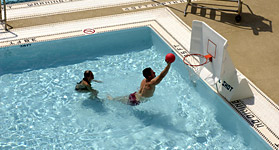Blair says there is no reason to believe that women would not show same benefits from swimming
February 3, 2009
Swimming cuts men’s risk of dying by about 50 per cent compared to runners, walkers and sedentary peers, according to Arnold School exercise expert Dr. Stephen Blair.
Blair's conclusion is based on an evaluation of comprehensive physical exams and behavioral surveys from thousands of people enrolled in the Aerobics Center Longitudinal Study (ACLS) over the last 32 years.
The results appeared in the International Journal of Aquatic Education and Research.

Shooting hoops in the pool at the
Strom Thurmond Center
"Swimmers had the lowest death rate," said Blair.
The study takes into account age, body mass index, smoking status, alcohol intake, hypertension, other medical factors and family history.
"This is the first report that examined mortality rates among swimmers in comparison with other types of physical activity and sedentary lifestyle. We conclude that men who swim for exercise have better survival rates than their sedentary peers," he said.
The ACLS includes extensive medical and physical activity data on more than 40,000 men, age 20-90 years. "These lower rates in swimmers compared with walkers and sedentary men might well be expected," said Blair, "but it is surprising that we also observed lower mortality in swimmers than in runners," he said.
"Therefore, swimming appears to be a healthful alternative to other types of physical activity." The study population was limited to white, well-educated, middle- to upper-class men. While this limits the ability to generalize the study, it should not affect the study’s internal validity," he said.
"There is no compelling reason to assume that the benefits of swimming would be different for women or for men in other socioeconomic groups. In an earlier study in this same population we found that both women and men had similar benefits from swimming in terms of fitness and other health indicators."
Blair also found that regular swimmers had a higher cardiorespiratory fitness than walkers and sedentary people.
He concludes that, "Swimming provides a healthful alternative to traditional modes of exercise for improving cardiorespiratory fitness and health for the general population, as well as for patients suffering from chronic diseases. Swimming may be a good alternative exercise for individuals who cannot participate in running or other forms of physical activity."
Future research will compare injury information between swimming and other forms of physical activity.
Founded in 1965, National Swimming Pool Foundation (NSPF), which helped fund this research, is a non-profit organization dedicated to improving public health worldwide by encouraging healthier living through aquatic education and research.
SPF is the leading educator of aquatic facility operators and the chief philanthropic research sponsor in the aquatics field. For additional information, visit www.nspf.org.



_01.jpg)
_02.jpg)